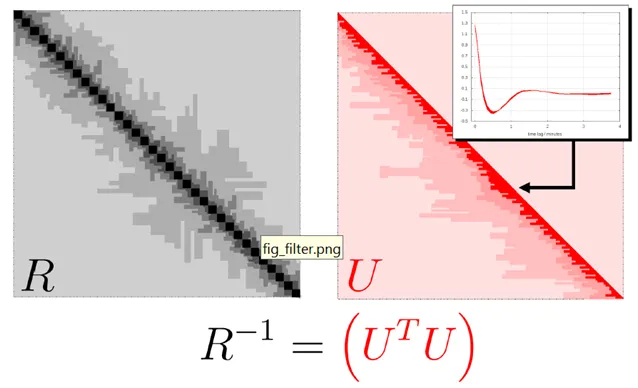
IP5: Improved Stochastic Modeling in GRACE/GRACE-FO Real Data Processing (ISTORE)
PI: Rolf König (GFZ)
Research Objectives
- Take into account extensive stochastic error characteristics of KBR/LRI and accelerometer (ACC) and test for real data applications
- Utilize full background model error VCMs of ocean tides and atmosphere/ocean, supported by Monte-Carlo simulations;
- Analyze impact of utilization of full error VCMs in real data processing
- Identify possible simplifications regarding stochastic modelling
Innovations
- Use of ocean tide and background model errors in real data processing
- Formal error propagation to gravity field model by Monte-Carlo simulations
Selected Results
In order to assess the impact of background model (BM) errors on the adjustable parameters, IP5 targeted in phase 1 to implement the handling of correlated observations and the error propagation of BMs into GFZ’s EPOS-OC (Earth Parameter and Orbit System – module Orbit Computation) software package used for GRACE/GRACE-FO real data processing. The utilization of the full static (not time depending) variance-covariance matrices (VCMs) of the applied GFZ RL06 BMs for ocean tides (OT; FES2014, Carrere et al. 2016) and atmosphere and ocean dealiasing (AO, AOD1B RL06) as provided by IP1 and IP2 has been performed in three steps.
In step 1 Monte Carlo (MC) simulations were performed to analyze which parts of the available AO and OT VCMs contribute significantly to the monthly gravity solution. To investigate the effect of the stochastic behavior of AO 30 GRACE real-data solutions for one month (January 2007) with different AOD1B models, which were varied up to degree and order (d/o) 5, 10, 15, 20, 25 and 30 using the full AO VCM, were computed. Additionally, the AOD1B coefficients also for degrees between 31 and 180 using corresponding AO VCM diagonal elements were varied. The conclusion was that the AOD1B coefficients should be modeled stochastically during real-data processing at least up to d/o 15. The MC simulations for the ocean tide model showed that, unlike the AOD1B model, the errors in the ocean tide harmonic coefficients influence the gravity field solutions till very high d/o. This is caused by the abrupt discontinuity between ocean and land areas which cannot be properly handled by the SH expansion. Consequently, areas close to the ocean-land boundary require much higher SH d/o compared to the open ocean. Therefore, all available stochastic information on the ocean tides has to be considered during real data processing.
Step 2 was the incorporation of the stochastic BM information into the EPOS-OC and in step 3 its application to GRACE/GRACE-FO real data processing. While AO is still ongoing, the implementation for OT has been finalized. For this, the tidal parameters were set up in the data processing to be estimated together with other parameters (e.g. gravity field spherical harmonic (SH) coefficients). The constraints for the ocean tides were provided by IP1 in terms of a VCM for the tidal SH coefficients up to d/o 30 for 8 main tidal waves.
Then the monthly gravity field coefficients were computed for all months of the year 2007 and compared to the GFZ RL06 monthly solutions, where all ocean tidal parameters are kept fixed. The results are shown in the following figure, where all 12 monthly solutions of the year 2007 are analyzed in terms of RMS values after reducing most of the signal in terms of a six parameter model (bias, trend, annual and semi-annual parameters). The formal errors get more realistic with increased values for the low SH d/o (top left, dashed lines, and bottom right). The residual RMS is slightly reduced for nearly the whole spectrum (top left, solid lines, and top right) resulting in reduced ocean RMS values by 5 % on average for different filter radii and DDK and Gaussian filtering (bottom left).

